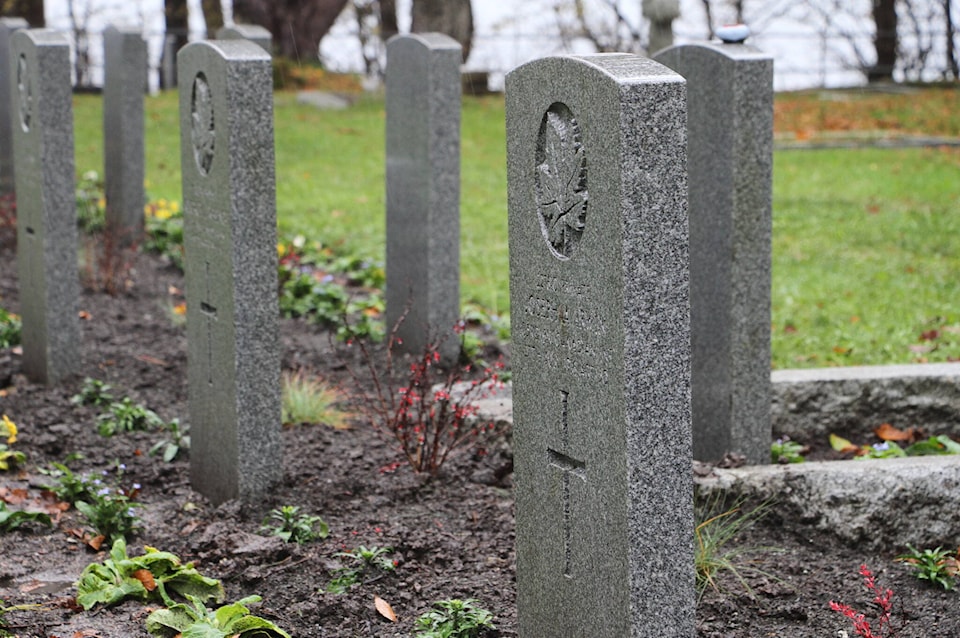Visit a Greater Victoria cemetery in November and you’ll find rows of grave markers decorated with poppies, wreaths and Canadian flags. What you won’t see, though, is the storied history of each headstone and the Canadian it honours.
“Going into a cemetery is like going into a bookstore,” Old Cemeteries Society volunteer John Azar told Black Press Media on a rainy afternoon in Fairfield’s Ross Bay Cemetery. “You see the covers of these books and you know there’s a story behind every one of them.”
The society works to restore and commemorate Victoria’s historical cemeteries. While military headstones don’t always tell the stories of those who died, volunteers like Azar are full of them.
“There’s a fellow at the other end of the cemetery by the name of Blaney Scott,” he said, pointing across the burial grounds.
“He served in the air force … his fuel tank was shot. Fuel was leaking out of the tank close to the wing, so he climbed out to go and plug it with rags … he ended up making it back.”
READ MORE: First poppy presented to West Shore WWII veteran
A collective responsibility for remembrance
Honouring deceased veterans has been a national effort since the First World War, where 66,655 Canadians gave their lives and another 172,950 were wounded.
The need for a federal response to the growing number of wartime casualties quickly became clear, Azar said.
“So many people were being killed that they couldn’t even send them back to Britain,” he explained.
As a result, the Commonwealth War Graves Commission was founded in 1917 to care for the graves of British soldiers who died and were buried overseas, as well as those who died from their injuries back home.
Some grave markers from that time period give us insight into how families coped. Oftentimes, Azar said, deceased relatives were commemorated on family headstones even though their bodies were buried elsewhere.
In Ross Bay Cemetery, part of an inscription on the Agnew family plot commemorating Maj. Augustus Agnew reads, “(he) fell in action at Courcelette … buried at Contay, France.”
READ MORE: Ross Bay cemetery ceremony little-known, but meaningful
Ensuring ‘dignity and grace’ after death
The commission stopped accepting new applications shortly after the Second World War. To support new armed forces members, a federal department called Veteran Affairs Canada (VAC) was created in 1944. On top of serving ill and injured veterans, the department provides burial assistance through the Last Post Fund.
The families of eligible veterans – those who died due to a service-related disability or have financial need – can apply for financial help with related funeral costs. VAC also provides a military-style grave marker for the deceased.
Registering, creating and maintaining the grave markers of more than 200,000 veterans across Canada is no small feat. Government employees catalogue the department’s headstones and log regular repairs and cleaning. Most stone cleaning is carried out by local contractors – either by hand, with a steam cleaner or with high-pressure water.
“Veterans Affairs Canada helps preserve the memory of deceased Canadians who served their country during war and peace by maintaining their final resting places,” a VAC representative told Black Press. “We remain committed to paying tribute to those who have served and will continue to care for their places of commemoration with the dignity and grace they deserve.”
Since 1947, VAC has also overseen Veterans Cemetery in Esquimalt, also known as God’s Acre. The grounds are the final resting place for more than 2,500 Canadian Armed Forces and RCMP veterans.
In 2018, the Government of Canada allocated $24.4 million over a five-year period to VAC so the department could clean and restore grave markers and repair almost 45,000 damaged graves across Canada. According to VAC, about 42,000 repairs have been made.
READ MORE: Victoria residents pay their respects
Honouring today’s sacrifices
Royal Oak Burial Park in Saanich contains 93 Commonwealth burials from the Second World War, as well as VAC-sponsored headstones for deceased Armed Forces members. According to business development and client services manager Lorraine Fracy, Canada’s involvement in the Afghan War and the advent of social media sparked a renewed interest in honouring the dead.
“The stories that were being told by the next generation … just became awe inspiring,” she said.
Certain high-profile deaths have brought extra attention to remembrance in Greater Victoria, Fracy added. In 2009, when Lt. Andrew Nuttall – who died while serving in Afghanistan – was buried in the park, Fracy said inquiries were constant.
“For the first couple of weeks, probably even into the first year, we were having daily and weekly requests for where Andrew was buried, so people could go up and pay tribute,” she said.
Royal Oak Burial Park holds a variety of commemorative services for Remembrance Day.
An initiative called No Stone Left Alone invites youth to lay poppies at headstones, and Fracy added a local resident takes it upon himself to place crosses at different military graves.
As she prepares for these programs, Fracy said she often has moments of pause.
“Coming into the fall is always a time of reflection,” Fracy said. “The crosses are that beautiful reminder of those that sacrificed for the freedoms that we have today.”
Do you have a story tip? Email: tegwyn.hughes@blackpress.ca.
Follow us on Twitter and Instagram, and like us on Facebook.
